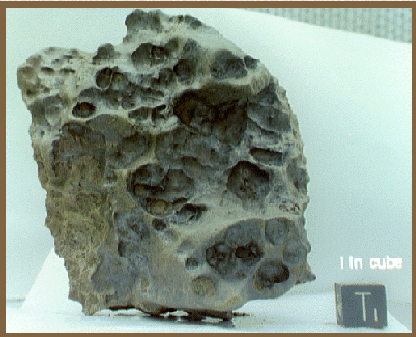 Lesson 1:
Lesson 1:
 Ecology of the System
Ecology of the System
|
 1.6
1.6
 Origin of the Solar System: Clues from Meteorites
Origin of the Solar System: Clues from Meteorites

|

Figure 1.6.1 Meteor Crater Barrington,Arizona.
|
Surely one of the more surprising observations in the natural world is
that stones can fall from the sky. Most of them are very small and burn
up in the atmosphere. At night, their trails can be seen as "falling
stars" or "shooting stars", faulty folk interpretations preserved in
language. If large enough, these particles can make it to the ground (or
into the ocean) as small molten droplets of rock. These are quite
well-known from deep-sea deposits. If larger, several cm in diameter,
they can survive the fall as a pebble of original rock, with a glassy
crust. Occasionally, meteorites are quite large. One of these made the
Meteor Crater in Arizona. Every year, it is estimated, about 10,000 tons
of stone and metal rains down on Earth, almost all objects smaller than
1 mm in size.
What are these objects and where do they come from?
Meteorites can be made of stone or iron. In fact, iron meteorites were
prized objects in the earliest days of civilization, as they delivered a
workable metal much harder and tougher than copper or bronze. (This is
due to the high nickel content; plain iron is much softer.) By far the
greater portion of meteorites are of the stony variety. A good place to
find meteorites is where people have not looked before, and where stones
are not normally expected to occur, namely on the ice covering
Antarctica. Hundreds of meteorites have been recovered from that region
since Japanese geologists first discovered the place as an ideal
collecting station (in 1969). Some of the fragments are thought to come
from the Moon and even from Mars. But the bulk is thought to be
leftovers from the time of the origin of the solar system, perhaps
fragments from one or more planets, formed early during the history of
the solar system and soon again destroyed by collision. Such debris is
abundant in the "asteroid belt", located between the orbits of Mars and
Jupiter. Others of the objects may be debris from disintegrated comets,
as suggested by the periodicity in meteorite showers following the
demise of certain comets.

|

Figure 1.6.2 Iron meteorite.
|
As mentioned, many meteorites studied turned out to be very old, more
than 4 billion years old in fact. They contain a trace, then, of the
early days of the solar system. From the very fact that there are both
stony and iron meteorites it can be deduced that they have a planet as a
source and that one or more planets therefore had to form very early in
the history of the system.
A planet is needed to provide the gravitational force to separate the
heavy metals (iron and nickel) from the accreted dust into a metallic
core. The material must have been molten, at least in part, so any
parent planet was hot. The energy of heating was provided by collision
and contraction, and presumably also by internal radioactive decay. It
has been suggested that there were still newly made radioactive elements
around, after a nearby supernova explosion, which could have delivered
the necessary heat for melting rock. If this is so, planet formation
must have started soon after the supernova debris was injected
into the cloud of hydrogen gas and dust that condensed into the
growing central body and its rotating disk in the first stage of solar
system formation (the "solar nebula" stage).
|
|
Figure 1.6.3 Formation of solar systems. The primordial
cloud of gas and dust begins to collapse under its own
gravity. The cloud fragments and each piece continues
to collapse. Finally there are 5 protostars surrounded by
disks of dusty gas that will form their planets.
|
Within this rotating disk there were preferred orbits, where rings of
gas and dust could travel around the emerging star at the center
without being gravitationally disrupted by adjacent growing planets.
Each such ring eventually produced a planet.
The young Sun had not yet found a longterm equilibrium; it burned
hot and variably and with a strong solar wind.
The gas in the inner rings was blown out to the outer ones, feeding the
growing large gas planets there. The inner rings concentrated solids
into large bodies, making the rocky planets we know. Some of these
(Venus, Earth) were big enough to replenish gaseous envelopes from their
rocky bodies, and hold on to their atmospheres despite the Sun's
radiation.
Whatever planet or planets formed next to Jupiter and inside its orbit
was doomed to failure, perhaps because of gravitational disturbances
from this largest of all planets, leading to collision and break-up. The
material remaining in this ring makes up the asteroid belt, with a mass
about 2 percent of that of the moon. The largest object is the asteroid
Ceres, which is a little less than 1000 km in diameter. The rocky
objects in this belt have the familiar meteorite composition, as far as
can be ascertained.

|

Figure 1.6.4 The asteroid Ida and its tiny moon Dactyl.
Taken in 1993 by the Galileo spacecraft from a distance
6,500 miles.
|
|





















